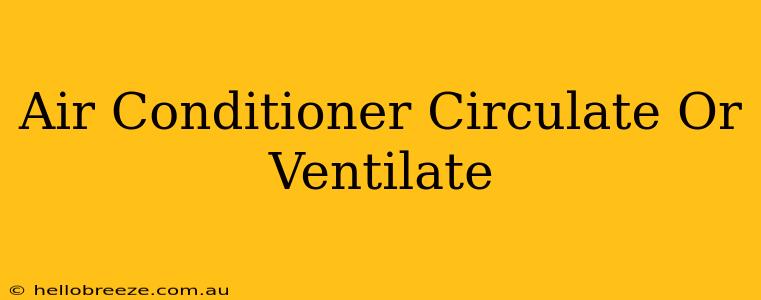Choosing between "circulate" and "ventilate" on your air conditioner might seem trivial, but understanding the difference is key to maximizing comfort and energy efficiency. This guide clarifies the functions and helps you decide which mode best suits your needs.
What Does "Circulate" Mode Do?
The "circulate" mode, sometimes labeled "fan only" or a similar term, simply runs the internal fan of your air conditioner. It doesn't engage the compressor, meaning it doesn't cool or heat the air. Instead, it circulates existing air, distributing it throughout the room. This is useful for:
- Distributing conditioned air: After your AC has cooled the room, circulate mode helps maintain a consistent temperature by gently moving the air.
- Air circulation without cooling: On mild days, you can use this mode to improve air quality without consuming the energy needed for cooling.
- Reducing stuffiness: Circulating the air can help remove stale air and prevent a stuffy feeling, even without cooling.
When to Use Circulate Mode:
- Maintaining comfortable temperature: Once your space is already cool.
- Improving air circulation without cooling: On days when the temperature is pleasant.
- Gentle air movement after turning off the AC: To help distribute the remaining cool air.
What Does "Ventilate" Mode Do? (External Air Circulation)
While "ventilate" isn't a standard term on all air conditioners, some models offer a ventilation mode or a similar function that brings in fresh outdoor air. This differs significantly from "circulate". Ventilation typically involves pulling in air from outside and either mixing it with existing indoor air or directly replacing indoor air. This helps with:
- Improving indoor air quality: Brings in fresh air, reducing the build-up of stale air, pollutants, and odors.
- Reducing humidity (in some cases): Depending on the outdoor air conditions, it can help lower humidity levels, especially in humid climates.
- Removing odors: Helps quickly eliminate unwanted smells such as cooking smells or pet odors.
When to Use Ventilate Mode (if available):
- Improving air quality: When you need to freshen up the indoor air.
- Reducing humidity (in suitable conditions): In less humid climates or during certain times of day.
- Removing strong odors: After cooking or cleaning.
Circulate vs. Ventilate: Key Differences Summarized
| Feature | Circulate Mode | Ventilate Mode (if available) |
|---|---|---|
| Air Source | Existing indoor air | Outdoor air |
| Cooling/Heating | No | Typically No (Unless combined with cooling/heating) |
| Energy Use | Low | Moderate (depending on the system and usage) |
| Primary Purpose | Distribute existing conditioned air | Improve air quality and freshness |
Choosing the Right Mode for Energy Efficiency
Using the right mode can significantly impact your energy bill. While "circulate" mode consumes minimal energy, "ventilate" mode uses more, particularly if it's bringing in hot or humid outside air. Always consider the outside temperature and humidity when deciding which mode to use.
Pro Tip: Regularly changing your air conditioner's filters helps ensure optimal performance in both modes.
By understanding the differences between "circulate" and "ventilate" modes, you can optimize your air conditioner's use for both comfort and energy savings. Remember to consult your air conditioner's manual for specific instructions and features.

